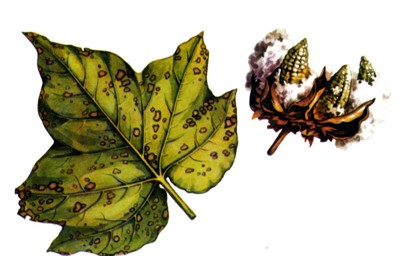Diseases
Alternaria gossypii (Jacz.) Nisik., K. Kimura and Miyaw.; Alternaria macrospora Zimm. - Alternaria Leaf Spot of Cotton.
Systematic position.
Kingdom Fungi, phylum Ascomycota, class Ascomycetes, order Pleosporales, family Pleosporaceae, genus Alternaria.Synonyms.
Macrosporium gossypii Jacz.; Alternaria longipedicellata Snowden.Biological group.
Saprotroph.Morphology and biology.
The causative agents of Alternaria Leaf Spot of Cotton (Macrosporium Leaf Spot) are fungi Alternaria gossypii and A. macrospora developing in their life cycle in only anamorphous stages. Mycelium of A. gossypii is dark brown. Conidiophores are brown, single or in groups. Conidia are light-brown, 22-27 x 9-11 mkm in. They affect cotton cotyledons in seedlings, also bolls and their fiber. Mycelium of A. macrospora is dark-brown. Conidiophores are light brown, single or in groups. Conidia are red-brown, 90-180 x 15-22 mkm in size. They affect leaves, bracts in seedlings and adult plants, bolls. The causative agents cause necroses on cotyledons, leaves, and bolls of cotton in form of dark-green and then brown, rounded or various shaped spots with clearly expressed zonality. At high humidity light pink or dark conidial sporulation appears on necrotic spots. Affected boll fiber is brownish-red. Systematic position of the causative agents of cotton alternariosis and macrosporiosis is sometimes considered indistinct; they may represent one or two different species (Gorlenko, 1968). Sources of the infection are affected cotton crop residues, seeds, and also weeds. Additional vectors of the infection are aphids parasitizing cotton plants.Distribution.
The Alternaria Leaf Spot is spread on cotton everywhere in the Central Asian and Caucasian countries of the former USSR.Ecology.
The causative agents affect cotton more intensively at high air humidity and at daily average temperature about 25°C. Strong severity of the disease is observed on old leaves with slow metabolic process.Economic significance.
At the moderate affection of cotton by the causative agents, assimilative processes are broken in leaves resulting in suppression of plant growth and reduction of yield. High severity of the infection causes strong defoliation of cotton, sharp decrease of yield and crude fiber quality. Gossypium barbadense cotton varieties are more strongly affected than varieties of Gossypium hirsutum. Control measures are crop rotations including alternation with cereals and unaffected crops, application of the biological preparation of Trichoderma, duly weed control in crops, the use of chemical control against the disease or aphids, if necessary.Reference citations:
Gorlenko M.V. 1968. Agricultural phytopathology. Moscow: Visshaya Shkola, 434 p. (In Russian).CABI Bioscience Databases. 2004. http://www.SpeciesFungorum.org .
Peresypkin V.F. 1974. Agricultural phytopathology. Moscow: Kolos, 560 p. (In Russian).
Peresypkin V.F. 1987. Atlas of diseases of field cultures. Kiev: Urozhai, 144 p. (In Russian).
Pidoplichko N.M. 1977. Fungi are parasites of cultural plants. Keys. Kiev: Naukova Dumka, Vol. 2. 299 p. (In Russian).


